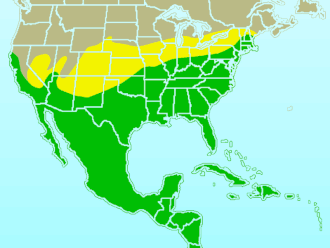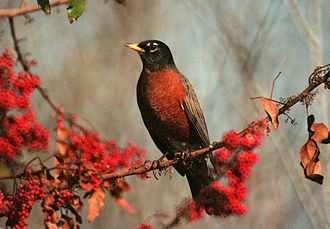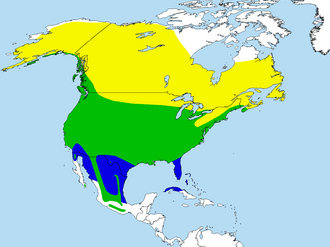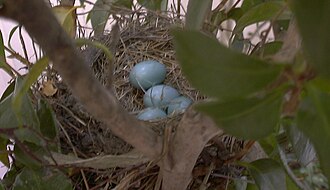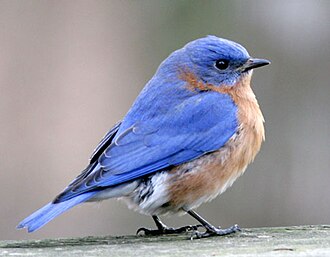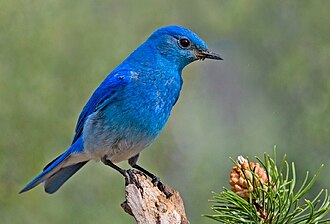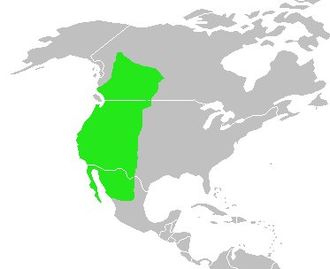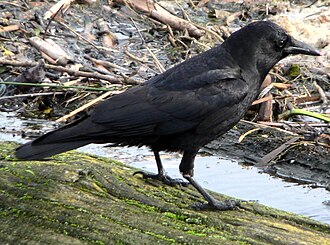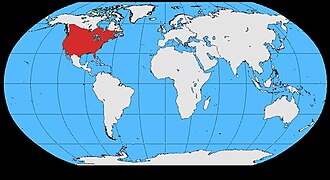Difference between revisions of "Field Guide/Birds/Western US and Canada"
| Line 15: | Line 15: | ||
{{:Adventist Youth Honors Answer Book/Nature/Birds/Redwinged Blackbird}} | {{:Adventist Youth Honors Answer Book/Nature/Birds/Redwinged Blackbird}} | ||
| − | {{: | + | {{:Field Guide/Birds/Corvus brachyrhynchos}} |
{{:Adventist Youth Honors Answer Book/Nature/Birds/Gray Catbird}} | {{:Adventist Youth Honors Answer Book/Nature/Birds/Gray Catbird}} | ||
Revision as of 00:57, 8 July 2008
The range maps presented here are color-coded, with yellow indicating the summer range, blue indicating the winter range, and green indicating the year-round range. Some of the range maps do not follow this color code, but it is not difficult to decode them.
Passerine (perching birds)
| Mimus polyglottos (Northern Mockingbird) | |
|---|---|
| Description | |
| The Northern Mockingbird builds a twig nest in a dense shrub or tree, which it aggressively defends against other birds and animals, including humans. When a predator is persistent, Mockingbirds from neighboring territories, summoned by a distinct call, may join the attack. Other birds may gather to watch as the Mockingbirds harass the intruder. This bird is mainly a permanent resident, but northern birds may move south during harsh weather. Mockingbirds have a strong preference for certain trees such as maple, sweetgum, and sycamore. They generally avoid pine trees after the other trees have grown their leaves. Also, they have a particular preference for high places, such as the topmost branches of trees. Although many species of bird imitate other birds, the Northern Mockingbird is the best known in North America for doing so. It not only imitates birds but also other animals and mechanical sounds. | |
| Turdus migratorius (American Robin) | |
|---|---|
| Description | |
| The American Robin has gray upperparts and head, and orange underparts, usually brighter in the male. Robins are frequently seen running across lawns, picking up earthworms by sight. In fact, the running and stopping behavior is a distinguishing characteristic. When stopping, they are believed to be listening for the movement of prey. | |
Adventist Youth Honors Answer Book/Nature/Birds/White-breasted Nuthatch
| Sialia (Bluebird) | |
|---|---|
| Description | |
| These are one of the relatively few thrush genera to be restricted to the Americas. As the name implies, these are attractive birds with blue, or blue and red, plumage. Female birds are less brightly colored than males, although color patterns are similar and there is no noticeable difference in size between sexes. There are three species of bluebird; the Eastern Bluebird, the Mountain Bluebird, and the Western Bluebird. The Western Bluebird is very similar to the Eastern Bluebird in appearance. | |
Adventist Youth Honors Answer Book/Nature/Birds/Redwinged Blackbird
| Corvus brachyrhynchos (American Crow) | |
|---|---|
| Description | |
| The American Crowis a common bird found throughout North America. Entirely black, it is an easily recognized bird.
The American Crow is a distinctive bird with iridescent black feathers. Its legs, feet and bill are also black. Several regional forms are recognized and differ in bill proportion and overall size from each other across North America, generally being smallest in the southeast and the far west. Averaging 18 inches (46 cm) in length, it is smaller than the Common Raven. American Crows have a lifespan of 7 to 8 years. Captive birds are known to have lived up to 30 years. The most usual call is a loud, short, and rapid "caah-caah-caah". Usually, the birds thrust their heads up and down as they utter this call. American Crows can also produce a wide variety of sounds and sometimes mimic noises made by other animals, including other birds. Crows live in virtually all types of country from wilderness, farmland, parks, open woodland to towns and major cities. The crow is generally a permanent resident, but many birds in the northern parts of the range migrate short distances southward. Outside of the nesting season, these birds often gather in large communal roosts at night. American Crows are protected by the Migratory Bird Treaty Act of 1918. The American Crow is omnivorous. It will feed on invertebrates of all types, carrion, scraps of human food, seeds, eggs and nestlings, stranded fish on the shore and various grains. American Crows are active hunters and will prey on mice, frogs, and other small animals. In winter and autumn, the diet of American Crows is more dependent on nuts and acorns. Occasionally, they will visit bird feeders. Like most crows, they will scavenge at rubbish dumps, scattering garbage in the process. Where available, corn, wheat and other agricultural crops are a favorite food. These habits have historically caused the American Crow to be considered a nuisance. However, it is suspected that the harm to crops is offset by the service the American Crow provides by eating insect pests. American Crows are monogamous cooperative breeding birds. Mated pairs form large families of up to 15 individuals from several breeding seasons that remain together for many years. Offspring from a previous nesting season will usually remain with the family to assist in rearing new nestlings. American Crows do not reach breeding age for at least two years. Most do not leave the nest to breed for four to five years. American Crows build bulky stick nests, nearly always in trees but sometimes also in large bushes and, very rarely, on the ground. They will nest in a wide variety of trees, including large conifers, although oaks are most often used. Three to six eggs are laid and incubated for 18 days. The young are fledged usually by about 35 days. Despite attempts by humans in some areas to drive away or eliminate these birds, they remain widespread and very common. The number of individual American Crows is estimated by Birdlife International to be around 31,000,000. The large population, as well as its vast range, are the reasons why the American Crow is considered to be of least concern, meaning that the species is not at immediate risk. | |
Adventist Youth Honors Answer Book/Nature/Birds/Gray Catbird
Adventist Youth Honors Answer Book/Nature/Birds/Brown-headed Cowbird
Piciformes (woodpeckers)
Adventist Youth Honors Answer Book/Nature/Birds/Red-headed Woodpecker
Adventist Youth Honors Answer Book/Nature/Birds/Pileated Woodpecker
Hummingbirds
Caprimulgiformes
Adventist Youth Honors Answer Book/Nature/Birds/Whip-poor-will
Galliformes (turkeys, chickens, grouse, quails, and pheasants)
Columbidae (doves and pigeons)
Adventist Youth Honors Answer Book/Nature/Birds/Rock Pigeon
Adventist Youth Honors Answer Book/Nature/Birds/Stock Pigeon
Adventist Youth Honors Answer Book/Nature/Birds/Band-tailed Pigeon
Adventist Youth Honors Answer Book/Nature/Birds/White-tipped Dove
Falconiformes (eagles, falcons, and hawks)
Adventist Youth Honors Answer Book/Nature/Birds/Bald Eagle
Adventist Youth Honors Answer Book/Nature/Birds/Golden Eagle
Adventist Youth Honors Answer Book/Nature/Birds/Peregrine Falcon
Adventist Youth Honors Answer Book/Nature/Birds/Red-tail Hawk
Adventist Youth Honors Answer Book/Nature/Birds/Osprey
Ciconiiformes (storks, herons, egrets)
Adventist Youth Honors Answer Book/Nature/Birds/Great Blue Heron
Adventist Youth Honors Answer Book/Nature/Birds/Great Egret
Charadriiformes (waders, gulls, and auks)
Adventist Youth Honors Answer Book/Nature/Birds/Herring Gull
Adventist Youth Honors Answer Book/Nature/Birds/Semipalmated Sandpiper
Anseriformes (ducks, geese, and swans)
Adventist Youth Honors Answer Book/Nature/Birds/Canada Goose
Adventist Youth Honors Answer Book/Nature/Birds/Northern Pintail

